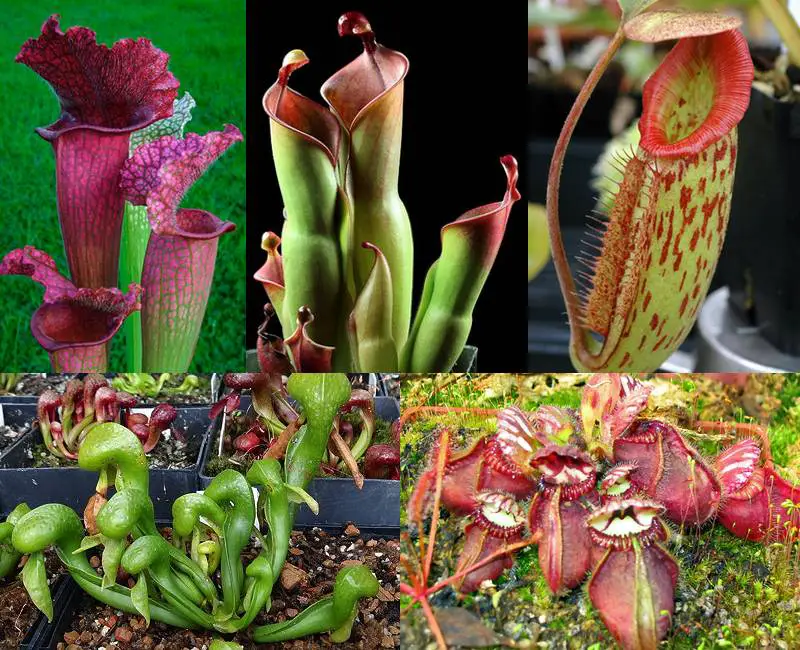Carnivorous Plant Care Guide (From Beginners to Advanced)
Although fascinating, carnivorous plants need a specific environment to survive. The specifics of how to take care of carnivorous plants are all covered in this article. It contains information on Cobra plants, Venus flytraps, Pitcher plants, Drosera, and more.
You’ve started a sizable succulent garden on your windowsill, picked up every houseplant on every beginner’s list, and dabbled in some exotic indoor plants, but you still yearn for more.
In humid, malnourished environments with lots of water, sunlight, and food sources, carnivorous plants thrive. Tropical carnivorous plants prefer a constant temperature year-round, while temperate carnivorous plants need a period of dormancy.

What Are Carnivorous Plants?
Why Consume Insects Carnivorous Plants?
Carnivorous plants need nutrients to stay healthy, just like you and I do. Insects, spiders, and crustaceans make up the majority of their diet, but occasionally you’ll see a small mammal or lizard caught in one of their snap traps. Most carnivorous plants digest their prey’s carcass once it has been captured in order to absorb these crucial nutrients.
Although the majority of live flypaper traps can exist without eating prey, they will thrive in the presence of healthy nutrients. The plant will not only develop more quickly, but it will also have a better chance of procreating successfully. Each species has a digestive system that has been specifically adapted to work in its endemic environment.
Types of Carnivorous Plants

There are many different types of carnivorous plants, not all of which are regarded as carnivorous. To ensure pollination, some plants in the family, such as the Aroid species, capture insects. Although it rarely occurs, carnivorous plants occasionally use their flowers as traps. Due to the fact that some plants use their sticky foliage more for defense than for nutrition, they are no longer classified as carnivorous. These plants are not considered insectivorous because they do not examine their prey before digestion, despite the fact that carnivorous plants enjoy eating insects.
The Venus Fly Trap Dionaea muscipula, Tropical Pitcher Plant Nepenthes, Bladderworts Bladderworts Utricularia, and Sundew Drosera are the four most popular carnivorous house plants available today. Venus fly traps are renowned for their quick snap-shut capability and catch the response.

Pitcher plants that develop a lobster pot trap to deceive prey include the cobra plant and Darlingtonia California, both of which can be found in Northern California. This growth structure makes it simple to enter the chamber but makes it challenging to leave by using obstacles like bristles or pointing hairs. A pitfall trap is made by some pitcher plants by developing digestive enzymes.
The prey is slowly digested after falling into a pool of digestive enzymes. Instead of producing digestive enzymes, sun pitchers collect rainwater and use bacteria to assimilate nutrients. One of the simplest carnivorous plants to grow, sundew’s sticky foliage and leaf surface may have insects trapped on them.

Eight genera—Bromeliaceae, Byblidaceae, Cephalotaceae, Droseraceae (which includes Cape Sundews and Venus flytrap), Drosophyllaceae, Lentibulariaceae, Nepenthaceae (Tropical Pitcher Plants), and the North American Pitcher Plant Sarracenia—represent the hundreds of species of carnivorous plants (Sarraceniaceae purpurea).
What Kind of Carnivorous Plant Pot Should You Use?

When purchased from garden centers, some carnivorous plants will include a plastic dome with a handle at the bottom. Even though it increases humidity, this will make mold more susceptible. Tropical pitcher plants can be temporarily housed in their dome but do need high humidity levels.
Carnivorous plants do not like to sit on standing water for long periods. They need water, but it should be flowing at all times.
To make sure your plants are in the best possible environment, especially if you live in a dry climate, you might want to think about spending money on a humidifier and moisture meter.
What is the Best Carnivorous Plant Care Soil?
As they are adapted to getting the majority of their nutrients from other sources, carnivorous plants can thrive in soil that is deficient in nutrients. At Perfect Plants, we combine premium ingredients with our potting soil to create the ideal environment for your carnivorous plant. For the best results when growing carnivorous plant varieties, use our Carnivorous Plant Soil Mix recipe, which also contains organic sphagnum peat moss, organic perlite, and organic sand.


To make soil for carnivorous plants, try these recipes:
- 1 part perlite to 4 parts peat moss
- 1 part sand, 3 parts sphagnum moss
- 1 part sand, 1 part peat
- 1 part perlite to 1 part sphagnum
- Peat, sphagnum, and sand in equal parts
How Often Do You Feed Carnivorous Plants

Most carnivorous plants do not need to be fed or fertilized. If they are grown in the proper environment, the plant will be able to capture prey on its own and provide its own nutrition. In order to survive, they typically only need to digest small insects once per month.
Never feed your plants with large pieces of food because this will confuse the plant and eventually cause it to die. If grown indoors, you can buy freeze-dried insects from your neighborhood pet store to feed your plant’s voracious appetite.
If you want to provide the right nutrition and environmental conditions for your carnivorous plant species, be sure to do your research on their specific needs.
Seeds vs Plant (Carnivorous Plant Care)

It’s now time to decide whether to buy seeds or a plant after selecting a carnivorous plant.
It is a unique experience to grow carnivorous plants from seeds because you can eventually watch the entire growth cycle. However, planting seeds is dangerous. The seeds are vulnerable to fungus invasions. Additionally, it will take a few weeks for the seeds to sprout. The plants will then be very small and take years to reach maturity. You should only try to grow carnivorous plants from seeds if you have a lot of patience and attention to detail. For a long time, the plants will be very small.
Growing plants is much more appropriate for a beginner. You can upgrade your setup by purchasing a young or mature plant. It is time to think about growing your plant from seeds or through propagation once you have mastered its care. Flowers are produced by mature carnivorous plants. It is possible to pollinate the flowers and gather seeds by doing so.
Let’s sum up what is really important when carnivorous plants care:
- Use distilled water, reverse osmosis water, or rainwater as pure water sources for carnivorous plants.
- Give plants that consume animals a lot of sunlight.
- Water frequently and maintain constant soil moisture.
- Avoid overwatering. Root rot is a problem for carnivorous plants.
- Your plant could die if you use ordinary potting soil. Use only soil devoid of minerals and nutrients.
- Put carnivorous plants outside so they can catch insects or you can feed them!
- Never give human food to carnivorous plants!
- Environments that are humid are advantageous but not required.
- Animal-eating plants shouldn’t be fertilized.
- Temperature extremes can cause your plant to die. Avoid burning them and freezing them in the winter.
- Some carnivorous plants need a period of dormancy.
- Trimming is not required. As they develop, carnivorous plants will lose leaves. As they appear, you can trim the dead leaves.
- Avoid using pots made of terracotta, unglazed ceramic, glass, or metal.
- Carnivorous plants should not be grown in a closed terrarium.
- Avoid unnecessary motion and stress.
- Watch out for fungi and insects. The usual suspects are vulnerable to carnivorous plants!
- They are fascinating to observe both when they are on display and when they are actively working.

Carnivorous plants are excellent housemates because they keep your kitchen free of bothersome flies, gnats, and mosquitoes. As long as you meet their needs for soil and water, the majority are simple to care for and will continue to thrive and eat.
Everyone can eat plants that are carnivorous. There are many options available to you, whether you’re a novice or an expert home gardener.
